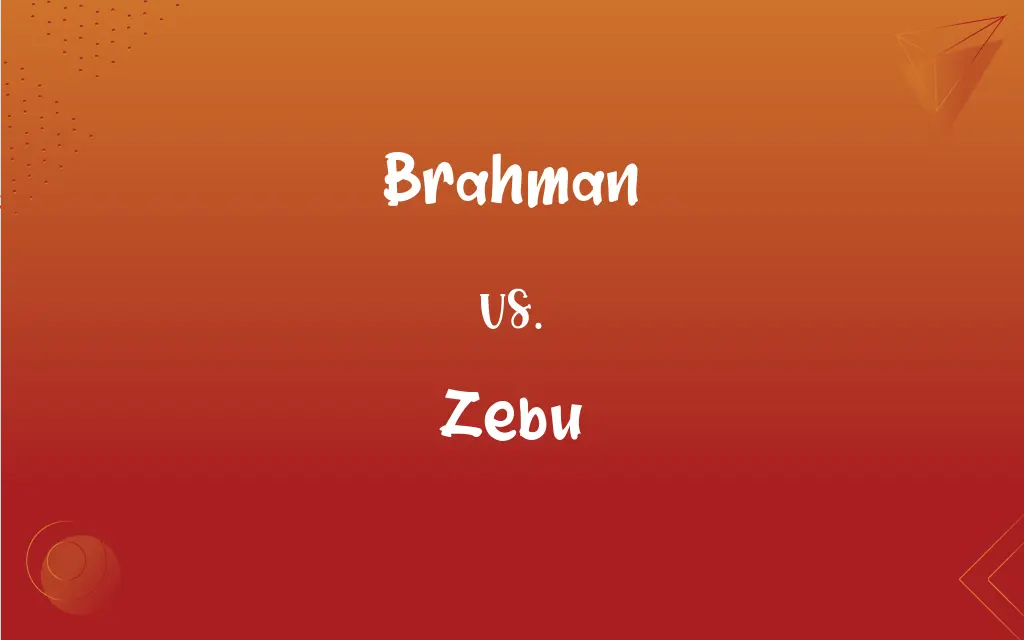Brahman vs. Zebu: What's the Difference?
By Janet White || Updated on May 20, 2024
Brahman is a breed of cattle developed in the United States from Indian cattle, known for heat resistance and adaptability. Zebu is a general term for humped cattle native to South Asia, characterized by a large hump and resistance to harsh climates.

Key Differences
Brahman cattle are a breed developed in the United States, originating from Indian cattle breeds like the Guzerat, Nelore, and Gir. They are well-known for their heat tolerance and ability to thrive in harsh conditions. Zebu, on the other hand, refers to a group of domestic cattle native to South Asia, specifically known for their prominent humps, large dewlaps, and drooping ears. Zebu cattle are highly adaptable to hot and humid environments, making them valuable in tropical regions.
Brahman cattle have been selectively bred to enhance specific traits such as increased size, improved muscle development, and greater resistance to pests and diseases. They are also used extensively in crossbreeding programs to improve other cattle breeds. Whereas Zebu cattle encompass various breeds, including Gir, Kankrej, and Sahiwal, they are generally smaller in size compared to Brahman. They are primarily used for milk production, draft work, and as a source of meat in their native regions.
Brahman cattle typically exhibit a lighter color, often gray or red, with a sleek, smooth coat that helps them manage heat. In contrast, Zebu cattle can vary in color but are often seen in shades of gray, white, or red, with a rougher coat texture.
Brahman cattle have been influential in developing other breeds worldwide, such as the Brangus and Simbrah. Zebu, however, remains more diverse in its pure form across South Asia and Africa, maintaining a wide genetic pool due to its various indigenous breeds.
Comparison Chart
Origin
United States, derived from Indian cattle
South Asia
ADVERTISEMENT
Distinguishing Feature
Developed breed with enhanced traits
General term for humped cattle
Size
Generally larger
Generally smaller
Coat
Sleek, smooth
Rougher texture
Uses
Meat production, crossbreeding
Milk, draft work, meat
Brahman and Zebu Definitions
Brahman
Typically gray or red in color.
The Brahman cow grazed peacefully in the pasture.
ADVERTISEMENT
Zebu
A group of humped cattle native to South Asia.
The Zebu cattle are common in India and Africa.
Brahman
Used extensively for crossbreeding to enhance other cattle breeds.
The farmer used a Brahman bull to improve his herd.
Zebu
Includes various breeds like Gir and Sahiwal.
The Gir is a well-known breed of Zebu cattle.
Brahman
Characterized by a large, drooping hump and loose skin.
The Brahman bull's hump was quite pronounced.
Zebu
Known for their large humps and drooping ears.
Zebu cows have distinctive physical features.
Brahman
A breed of cattle developed in the U.S. from Indian breeds.
The Brahman cattle are well-adapted to hot climates.
Zebu
Adapted to hot, humid climates.
Zebu cattle are well-suited for tropical environments.
Brahman
The divine and absolute power of being that is the source and sustainer of the universe.
Zebu
Used for milk production, draft work, and meat.
The Zebu cow provided milk for the farmer's family.
Brahman
The divine universal consciousness pervading the universe and sustaining the souls of individual persons; Atman.
Zebu
A domesticated ox (Bos indicus syn. B. taurus subsp. indicus) native to Asia and Africa, having a prominent hump on the back and a large dewlap.
Brahman
A religious formula or prayer and the holy or sacred power in it and in the officiating priest.
Zebu
A domesticated ox native to Asia and Africa, having a large fleshy hump on its back and a dewlap (Bos primigenius indicus).
Brahman
Variant of Brahmin..
Zebu
A bovine mammal (Ros Indicus) extensively domesticated in India, China, the East Indies, and East Africa. It usually has short horns, large pendulous ears, slender legs, a large dewlap, and a large, prominent hump over the shoulders; but these characters vary in different domestic breeds, which range in size from that of the common ox to that of a large mastiff.
Brahman
Also Brah·ma (-mə) or Brah·min (-mĭn) Any of a breed of beef cattle developed in the southern United States from stock originating in India and having a hump between the shoulders and a pendulous dewlap. They can tolerate heat and are often used for crossbreeding.
Zebu
Domesticated ox having a humped back and long horns and a large dewlap; used chiefly as a draft animal in India and east Asia
Brahman
Variant of Brahmin.
Brahman
Member of the Hindu priestly class.
Brahman
A person of the highest or sacerdotal caste among the Hindus.
Brahman
A person from an old, respected, and usually wealthy family who has considerable social or political influence; - a term used especially in New England; as, a Boston brahmin.
Brahman
A member of a social and cultural elite (especially a descendant of an old New England family);
A Boston Brahman
Brahman
A member of the highest of the four Hindu varnas;
Originally all brahmans were priests
Brahman
The highest of the four varnas: the priestly or sacerdotal category
Brahman
Any of several breeds of Indian cattle; especially a large American heat and tick resistant grayish humped breed evolved in the Gulf States by interbreeding Indian cattle and now used chiefly for crossbreeding
Brahman
Known for their resistance to heat and pests.
Brahman cows thrive in tropical regions.
FAQs
What distinguishes Zebu cattle?
Zebu cattle are characterized by their prominent humps, large dewlaps, and drooping ears.
In which regions are Zebu cattle commonly found?
Zebu cattle are commonly found in South Asia and Africa.
What is the origin of Brahman cattle?
Brahman cattle were developed in the United States from Indian cattle breeds.
What are the primary uses of Brahman cattle?
Brahman cattle are primarily used for meat production and crossbreeding.
What is a notable physical feature of Brahman cattle?
A notable physical feature of Brahman cattle is their large, drooping hump.
Why are Brahman cattle popular in crossbreeding?
Brahman cattle are popular in crossbreeding due to their heat tolerance and pest resistance.
What types of work are Zebu cattle used for?
Zebu cattle are used for milk production, draft work, and as a source of meat.
Which breed has a larger genetic pool, Brahman or Zebu?
Zebu cattle have a larger genetic pool due to their diverse indigenous breeds.
What color are Brahman cattle typically?
Brahman cattle are typically gray or red in color.
Do Brahman cattle originate from a single breed?
No, Brahman cattle originate from several Indian breeds, including Guzerat, Nelore, and Gir.
Are Zebu cattle found outside of South Asia?
Yes, Zebu cattle are also found in Africa and other tropical regions.
What is the primary climate adaptability of Brahman cattle?
Brahman cattle are highly adaptable to hot and dry climates.
What is the role of Zebu cattle in agriculture?
Zebu cattle play a significant role in agriculture, especially in milk production and draft work.
What is a common crossbreed involving Brahman cattle?
A common crossbreed involving Brahman cattle is the Brangus (Brahman and Angus).
How does the coat of Brahman cattle differ from Zebu cattle?
Brahman cattle have a sleek, smooth coat, whereas Zebu cattle have a rougher coat texture.
Are Zebu cattle larger or smaller than Brahman cattle?
Zebu cattle are generally smaller than Brahman cattle.
What are the distinguishing features of Zebu cattle breeds like Gir?
Breeds like Gir have distinctive physical features such as large, curved horns and a distinctive coat pattern.
Do Zebu cattle have any special dietary needs?
Zebu cattle can thrive on low-quality forage due to their adaptability.
Can Zebu cattle be used in crossbreeding?
Yes, Zebu cattle can be used in crossbreeding, but they are less commonly used for this purpose compared to Brahman.
Which breed is known for greater muscle development, Brahman or Zebu?
Brahman cattle are known for greater muscle development.
About Author
Written by
Janet WhiteJanet White has been an esteemed writer and blogger for Difference Wiki. Holding a Master's degree in Science and Medical Journalism from the prestigious Boston University, she has consistently demonstrated her expertise and passion for her field. When she's not immersed in her work, Janet relishes her time exercising, delving into a good book, and cherishing moments with friends and family.































































